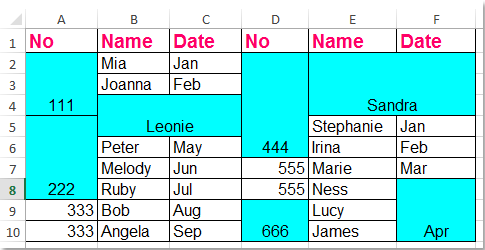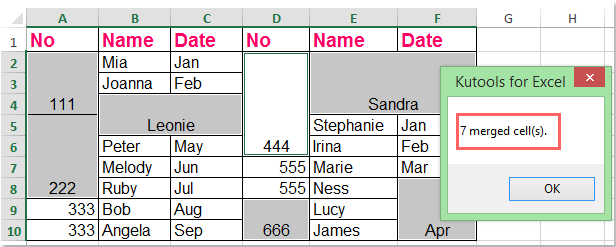Wie kann man alle zusammengeführten Zellen in Excel identifizieren und auswählen?
Wissen Sie, wie man alle zusammengeführten Zellen in Excel findet und auswählt? Hier sind drei clevere Methoden, um alle zusammengeführten Zellen in einer Auswahl oder einem Bereich in Excel schnell zu identifizieren und auszuwählen.

Zusammengeführte Zellen mit dem Suchbefehl identifizieren und auswählen
Schnell alle zusammengeführten Zellen mit Kutools für Excel auswählen und zählen
Zusammengeführte Zellen mit dem Suchbefehl identifizieren und auswählen
Sie können alle zusammengeführten Zellen im aktiven Arbeitsblatt mit dem Suchbefehl durch folgende Schritte identifizieren und auswählen:
1. Klicken Sie auf Start > Suchen & Auswählen > Suchen, um das Dialogfeld „Suchen und Ersetzen“ zu öffnen. Sie können das Dialogfeld „Suchen und Ersetzen“ auch öffnen, indem Sie die Tastenkombination Strg + F drücken.
2. Klicken Sie in dem Dialogfeld auf die Schaltfläche Format (Wenn Sie die Schaltfläche Format nicht finden können, klicken Sie bitte auf die Schaltfläche Optionen, um das Dialogfeld zu erweitern.) siehe Screenshot:

3. Aktivieren Sie im erscheinenden Dialogfeld „Suchformat“ nur die Option Zusammengeführte Zellen im Textsteuerungsabschnitt unter der Registerkarte Ausrichtung und klicken Sie auf OK.

4. Nun kehren Sie zum Dialogfeld „ Suchen und Ersetzen“ zurück, klicken Sie auf die Schaltfläche Alle suchen. Alle zusammengeführten Zellen werden am unteren Rand dieses Dialogfelds aufgelistet. Wählen Sie alle Suchergebnisse aus, während Sie die Umschalttaste gedrückt halten.
Nun werden alle zusammengeführten Zellen im aktiven Blatt ausgewählt, wenn Sie alle Suchergebnisse auswählen. Siehe Screenshot:

Tipp: Wenn Sie nur zusammengeführte Zellen in einer Auswahl identifizieren, finden und auswählen möchten, müssen Sie zuerst den Bereich auswählen.
Alle zusammengeführten Zellen mit Kutools für Excel auswählen und zählen
Das Tool „Zusammengeführte Zellen auswählen“ von Kutools für Excel hilft Ihnen, alle zusammengeführten Zellen in einer Auswahl mit nur einem Klick zu identifizieren, zu finden und auszuwählen.
Nach der Installation von Kutools für Excel gehen Sie bitte wie folgt vor: ( Jetzt kostenlos Kutools für Excel herunterladen! )
1. Wählen Sie den Datenbereich aus, in dem Sie die zusammengeführten Zellen auswählen möchten.
2. Klicken Sie auf Kutools > Auswählen > Zusammengeführte Zellen auswählen, siehe Screenshot:

3. Und alle zusammengeführten Zellen in der Auswahl werden auf einmal ausgewählt, und die Anzahl der zusammengeführten Zellen wird ebenfalls gezählt, siehe Screenshot:
Alle zusammengeführten Zellen mit VBA-Code identifizieren
VBA 1: Alle zusammengeführten Zellen identifizieren und hervorheben
1. Halten Sie die ALT + F11-Tasten gedrückt, und es öffnet sich das Fenster Microsoft Visual Basic für Applikationen.
2. Klicken Sie auf Einfügen > Modul und fügen Sie das folgende Makro in das Modulfenster ein.
Sub FindMergedcells()
'updateby Extendoffice
Dim x As Range
For Each x In ActiveSheet.UsedRange
If x.MergeCells Then
x.Interior.ColorIndex = 8
End If
Next
End Sub
3. Drücken Sie die F5-Taste, um dieses Makro auszuführen. Alle zusammengeführten Zellen im aktiven Arbeitsblatt werden identifiziert und hervorgehoben, siehe Screenshot:

VBA 2: Alle zusammengeführten Zellen identifizieren und auflisten
1. Halten Sie die ALT + F11-Tasten gedrückt, und es öffnet sich das Fenster Microsoft Visual Basic für Applikationen.
2. Klicken Sie auf Einfügen > Modul und fügen Sie das folgende Makro in das Modulfenster ein.
Sub ListMergedcells()
'updateby Extendoffice
Dim x As Range
Dim sMsg As String
sMsg = ""
For Each x In ActiveSheet.UsedRange
If x.MergeCells Then
If sMsg = "" Then
sMsg = "Merged cells:" & vbCr
End If
sMsg = sMsg & Replace(x.Address, "$", "") & vbCr
End If
Next
If sMsg = "" Then
sMsg = "No merged cells."
End If
MsgBox sMsg
End Sub
3. Drücken Sie die F5-Taste, um dieses Makro auszuführen, alle zusammengeführten Zellen werden in einem erscheinenden Dialogfeld aufgelistet. Siehe Screenshot:

Verwandte Artikel
Wie kann man das Zusammenführen von Zellen in einem geschützten Arbeitsblatt in Excel zulassen?
Standardmäßig erlaubt ein geschütztes Arbeitsblatt Benutzern nicht, Zellen zusammenzuführen. Mit der VBA-Methode, die wir in diesem Artikel bereitstellen, können Sie jedoch Zellen innerhalb eines geschützten Arbeitsblatts zusammenführen.
Wie kann man Zellen in einem als Tabelle formatierten Bereich in Excel zusammenführen?
In Excel können Sie problemlos einige aufeinanderfolgende Zellen mit der Funktion „Zusammenführen und zentrieren“ zu einer einzigen Zelle zusammenführen, wie im folgenden Screenshot gezeigt. Es kann jedoch keine Zellen in einem Bereich zusammenführen, der als Tabelle formatiert ist. Gibt es einen Trick, um dies zu bewerkstelligen?
Wie kann man Zellen in Excel zusammenführen, ohne den Inhalt zu zentrieren?
In Excel kann die Funktion „Zusammenführen und zentrieren“ helfen, zwei oder mehr Zellen zusammenzuführen. Aber was tun Sie, wenn Sie die Zellen nur zusammenführen möchten, ohne den Inhalt zu zentrieren, wie im folgenden Screenshot gezeigt? In diesem Tutorial stelle ich Methoden zur Lösung dieser Aufgabe in Excel vor.
Wie kann man Zellen in Excel aufteilen und mit doppelten Werten füllen?
Wenn Sie ein Arbeitsblatt haben, das zahlreiche zusammengeführte Zellen enthält, und Sie diese nun aufteilen und automatisch mit den ursprünglichen Werten aus den zusammengeführten Zellen nach unten füllen möchten, wie in den folgenden Screenshots gezeigt. Wie könnten Sie diese Aufgabe schnell erledigen?
Die besten Produktivitätstools für das Büro
Stärken Sie Ihre Excel-Fähigkeiten mit Kutools für Excel und genießen Sie Effizienz wie nie zuvor. Kutools für Excel bietet mehr als300 erweiterte Funktionen, um die Produktivität zu steigern und Zeit zu sparen. Klicken Sie hier, um die Funktion zu erhalten, die Sie am meisten benötigen...
Office Tab bringt die Tab-Oberfläche in Office und macht Ihre Arbeit wesentlich einfacher
- Aktivieren Sie die Tabulator-Bearbeitung und das Lesen in Word, Excel, PowerPoint, Publisher, Access, Visio und Project.
- Öffnen und erstellen Sie mehrere Dokumente in neuen Tabs innerhalb desselben Fensters, statt in neuen Einzelfenstern.
- Steigert Ihre Produktivität um50 % und reduziert hunderte Mausklicks täglich!
Alle Kutools-Add-Ins. Ein Installationspaket
Das Kutools for Office-Paket bündelt Add-Ins für Excel, Word, Outlook & PowerPoint sowie Office Tab Pro und ist ideal für Teams, die mit mehreren Office-Anwendungen arbeiten.
- All-in-One-Paket — Add-Ins für Excel, Word, Outlook & PowerPoint + Office Tab Pro
- Ein Installationspaket, eine Lizenz — in wenigen Minuten einsatzbereit (MSI-kompatibel)
- Besser gemeinsam — optimierte Produktivität in allen Office-Anwendungen
- 30 Tage kostenlos testen — keine Registrierung, keine Kreditkarte erforderlich
- Bestes Preis-Leistungs-Verhältnis — günstiger als Einzelkauf der Add-Ins
